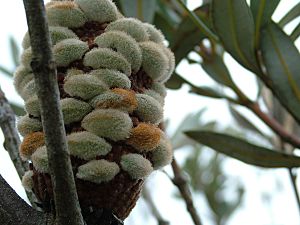Rock banksia facts for kids
Quick facts for kids Rock banksia |
|
|---|---|
 |
|
| Scientific classification | |
| Kingdom: | |
| (unranked): | |
| (unranked): | |
| Order: | |
| Family: | |
| Genus: | |
| Species: |
B. saxicola
|
| Binomial name | |
| Banksia saxicola A.S.George
|
|
The Banksia saxicola, also known as the rock banksia or Grampians banksia, is a special type of tree or shrub. It belongs to the Banksia plant family. You can find it growing in Victoria, Australia. It lives in two main areas: The Grampians and Wilsons Promontory. For a long time, people thought it was just a different version of another banksia, B. integrifolia. But in 1981, a scientist named Alex George said it was its own unique species. It is most closely related to the Banksia marginata.
Near the coast, the rock banksia can grow into a tree as tall as 13 meters (about 43 feet). But in the mountains, it's more of a shrub, growing up to 5 meters (about 16 feet) tall. In very windy or open spots, it might only reach 2 meters (about 7 feet) high. This plant has tough, green leaves that feel like leather. Its grey-yellow flower spikes appear in summer and early autumn. After the flowers fall off, furry seed pods grow on the spikes.
Contents
What Does the Rock Banksia Look Like?
The Banksia saxicola changes its shape depending on where it grows. At Wilsons Promontory, it can be a tall, straight tree, reaching up to 13 meters (43 feet) high. But in the Grampians, it's usually a sprawling shrub. Even in sheltered spots there, it stays a spreading plant, growing to about 5 meters (16 feet) tall. In very open, windy areas, it might only be 2 meters (7 feet) high.
New parts of the plant, like leaves and stems, grow in summer. The bark is about 2–4 millimeters thick. On younger plants, it's brown, but on older ones, it turns grey and often has lichen growing on it. The leaves are dark green and feel leathery. They are shaped like an oval and are about 4 to 10 centimeters (1.6 to 3.9 inches) long and 1 to 3.5 centimeters (0.39 to 1.38 inches) wide. They grow in circles around the stems, each on a short stalk (called a petiole) about 5–10 millimeters long.
The rock banksia flowers from January to March, sometimes even in May. Its flower spikes are shaped like cylinders. They grow on branches that are two to six years old. These spikes are about 3.5 to 8 centimeters (1.4 to 3.1 inches) tall and 5 to 6 centimeters (2.0 to 2.4 inches) wide when the flowers are fully open. After the flowers get old, they fall off, leaving the spikes bare. Then, 20 to 60 seed pods (called follicles) grow on the spikes. These pods are covered in fine fur and only open up after a bushfire.
How Scientists Classify the Rock Banksia
For a long time, people thought the Banksia saxicola was just a type of Banksia integrifolia. But in 1981, a botanist named Alex George officially described it as its own unique species. He did this in his big book about the Banksia genus. The name saxicola comes from two Latin words: saxum, meaning "rock," and cŏlo, meaning "to inhabit" or "grow in." This name perfectly describes where it lives! The first plant used to describe the species was found on Mount William in the Grampians in 1977. Alex George believed it was most closely related to Banksia canei.
Scientists have continued to study the relationships between different banksia plants. Since 1998, botanists like Austin Mast have been using DNA to figure out how banksias are related. Their studies suggest that Banksia saxicola is actually most closely related to Banksia marginata. Another study in 2013, using DNA from plant cells, confirmed that B. saxicola and B. marginata are closest relatives, and B. integrifolia is the next closest.
Where Does the Rock Banksia Grow?
In The Grampians, Banksia saxicola likes to grow on open mountain tops and slopes. It also grows in gullies, which are small valleys. It prefers loamy soil, often found among sandstone rocks. You might see it growing with other plants like the brown stringybark tree (Eucalyptus baxteri).
Rock banksias have been found on many mountains in the Grampians, including Mt William, Major Mitchell Plateau, Mt Lubra, Mt Rosea, Mt Difficult, Stony Peak, Mt Thackeray, and Chimney Pots Gap. The plants furthest north are on the edge of Mt Difficult Plateau, about 9 kilometers (5.6 miles) southeast of Wartook. In these areas, it grows at altitudes higher than 600 meters (about 2,000 feet). At Wilsons Promontory, it grows in taller forests at lower altitudes, usually between 200 to 300 meters (about 660 to 980 feet).
Life Cycle and How It Survives
When a bushfire happens, Banksia saxicola plants are usually killed. However, they are very clever! New plants grow from seeds that are released after the fire. It takes about four to five years for a new plant to grow big enough to produce its own flowers.
The flower spikes of banksias are very important for many animals. They provide a lot of sweet nectar (a sugary liquid). Mammals, insects, and especially birds like honeyeaters love to visit them for food. Birds that have been seen visiting the flower spikes of B. saxicola include the New Holland honeyeater and the crescent honeyeater.
Can You Grow a Rock Banksia?
The Banksia saxicola is quite easy to grow in gardens, especially in places with cooler weather. It has even been grown in the United Kingdom, Tasmania, and the Netherlands! People like to grow it because of its attractive leaves and its furry seed pods, which can look like they've been dusted with snow. If you plant a seed, it will usually start to flower in 3 to 4 years.

